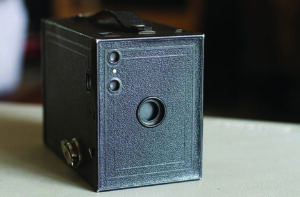(Editor’s note: DeeDee Wood is the owner of Black Cat Curiosities, an online antiques research and sales venue.)

Many users of The Brownie admired the clear shots and were impressed by the quality of the film, which measured, in the initial size of the first Brownie, at around 2.25 inches for a negative. (Photo courtesy WikiCommons)
Photography has a long history of trial and error, experimentation of materials, many different camera styles, and other attempts of capturing the world on film.
In 1900, the public was introduced to something George Eastman, owner of Eastman Kodak Company, called “The Brownie.”
It was a simplistic camera, that was basically a cardboard box with various user controls mounted on areas of the creation, that aided the normal person in taking “snapshots” with Kodak’s relatively new creation of roll film, (instead of heavy, cumbersome photography plates.)
The camera sold for $1 and in its initial year, which is around $37 in today’s money, and in that year, more than 100,000 of them were sold.
People enjoyed the convex/concave lens that took small pictures with roll film, and it was easy to use, convenient to transport, and in the growing middle-class budget.
Film processing from the rolled film used was relatively inexpensive as well, which also appealed to the general public looking for easy way to capture photos and learn photography.
Frank Brownell invented the camera for Eastman Kodak, originally a Rochester, N.Y. company, and the name of the camera came from popular characters in children’s books of the time, a “Brownie” representing sprites and magical beings from European folklore.
The box in which the camera came in had images of the Brownie characters on the outside of the box, which also marketed the “easy use” camera to children and youth.
The camera’s ease of use is what really introduced people to the joys of portable photography.
It had a lens, a simple shutter, a hole aperture for lighting choices, and a lever.
Several winding knobs allowed advancement of frames, and a viewfinder on the top guided the user.
The film could be sent to Kodak directly, or if available, could be processed in a local lab.
Many users of The Brownie admired the clear shots and were impressed by the quality of the film, which measured, in the initial size of the first Brownie, at around 2.25 inches for a negative.
In a world where former photography processes involved slow aperture speeds, sitting for long periods of time to expose film, cumbersome film tripods, and more, the cost and delay prohibited general access to such film endeavors.
The heavy chemical plates for image transference were difficult to handle, and there was an expensive processing of photos through a chemical process.
The Brownie was a welcome addition to the public’s growing interest in capturing their world on film, as rolls of film and the use of this simple box made the entire process affordable and much more simplistic from a logistic standpoint.
The Brownie had many different models created as time went on in the photography business, but the original 1900 Brownie was the first love affair the general public felt comfortable and excited about using, mainly due to its ease of use, portable qualities, and decent results of subject matter of the world around them.
During a time when companies, such as Eastman Kodak, were learning marketing to a broad, generalized audience, something we call “mass marketing” today,
The Brownie showed up at the right time when there was excitement for photography, inexpensive options, and public enthusiasm created by the excitement to document the world around them.



